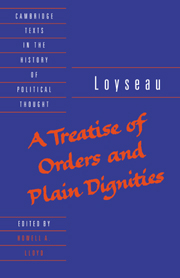Book contents
- Frontmatter
- Contents
- Acknowledgements
- Introduction
- Principal events in Loyseau's life
- Bibliographical note
- Note on translation and citations
- List of abbreviations
- Biographical notes
- Dedicatory epistle: Charles Loyseau to the Honourable Jean Forget
- Preface
- 1 Of order in general
- 2 Of the Roman orders
- 3 Of the order of the clergy
- 4 Of the order of nobility in general
- 5 Of plain gentlemen
- 6 Of the high nobility
- 7 Of princes
- 8 Of the third estate
- 9 Of solemn deprivation of order
- 10 Of the plain dignities of Rome
- 11 Of the plain dignities of France
- Index
- Title in the Series
2 - Of the Roman orders
Published online by Cambridge University Press: 05 June 2012
- Frontmatter
- Contents
- Acknowledgements
- Introduction
- Principal events in Loyseau's life
- Bibliographical note
- Note on translation and citations
- List of abbreviations
- Biographical notes
- Dedicatory epistle: Charles Loyseau to the Honourable Jean Forget
- Preface
- 1 Of order in general
- 2 Of the Roman orders
- 3 Of the order of the clergy
- 4 Of the order of nobility in general
- 5 Of plain gentlemen
- 6 Of the high nobility
- 7 Of princes
- 8 Of the third estate
- 9 Of solemn deprivation of order
- 10 Of the plain dignities of Rome
- 11 Of the plain dignities of France
- Index
- Title in the Series
Summary
1. In Rome, as in France, there were three orders, or estates, which included all the people. But they were different from ours: for whereas we have the clergy, the nobility and the third estate, they had the senate, the knights and the common people. ‘Rome, city of Mars, has three orders: knights, plebeians, senators’, says Ausonius. The senate was for counsel, the knights for the exercise of force, and the common people for supplying the needs of the commonwealth.
2. Some ascribe this differentiation of the people to Romulus. As [Servius] and Dionysius of Halicarnassus say, he chose a hundred elders from among the most noble of his people for his council, and called them priests. He also chose three hundred young men for his guard, and called them ‘the swift’ either because of their speediness or after the name of their first captain who, indeed, was the second person in the kingdom, just as afterwards in the Republic the master of the horse was the second person after the dictator, and in the Empire the praetorian prefect after the emperor.
3. But [the elder] Pliny tells us that the Roman knights never constituted a distinct order until the time of the Gracchi and when they had acquired the authority and duty of judging cases at law.
- Type
- Chapter
- Information
- A Treatise of Orders and Plain Dignities , pp. 23 - 47Publisher: Cambridge University PressPrint publication year: 1994



